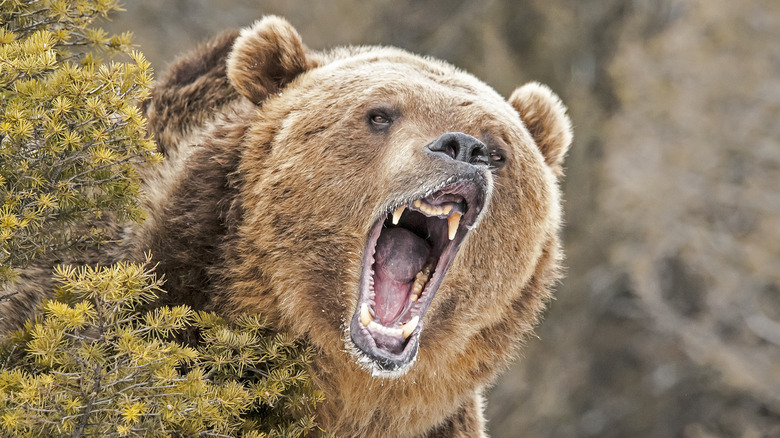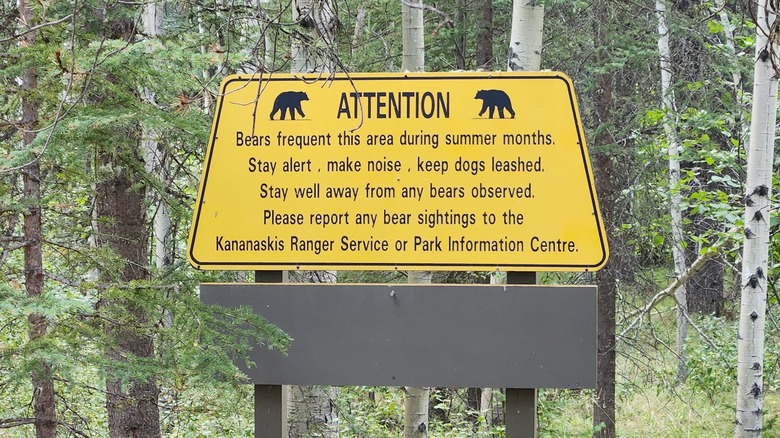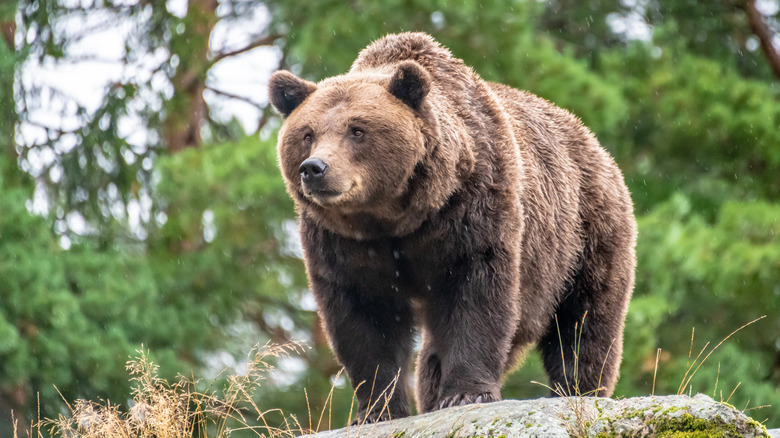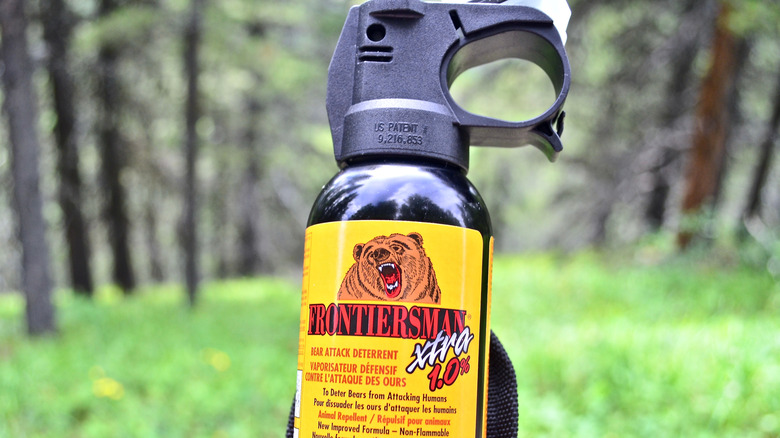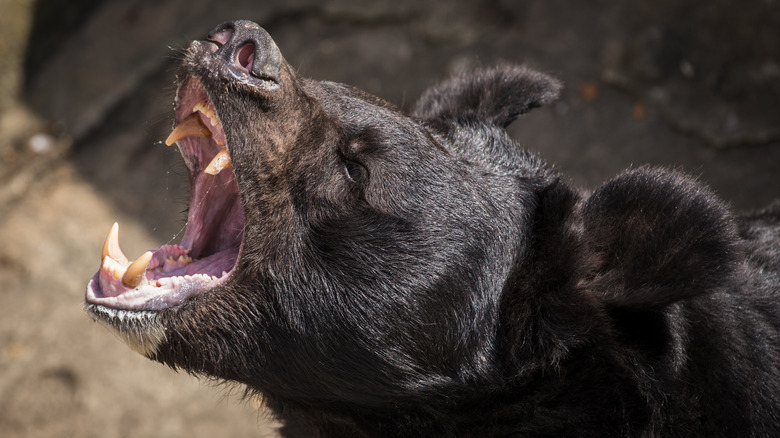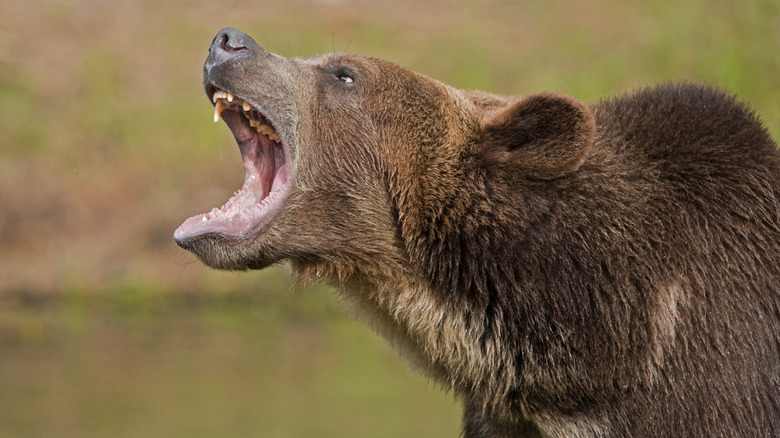What To Do If You're Attacked By A Bear
The image of a towering grizzly with teeth bared and claws extended is the stuff of nightmares for many who spend time adventuring in bear territory. This is certainly not without merit, as grizzlies are one of the most dangerous bears on the planet, and an encounter with a bear can be terrifying.
In many ways, bears are the land-based equivalent of sharks — people fear them, they are deadly, and there are documented accounts of attacks, including fatal ones. However, as is the case with sharks, though they may be sensational, bear attacks are relatively rare but still possible.
According to a 2019 article published in Scientific Reports, since 2000, there has been an average of around a dozen bear attacks a year in North America. As both the bear population and number of people spending time outdoors increases across much of North America, it's logical to expect the likelihood of encounters to increase as well. However, although bear attacks are a very real danger in areas they are known to roam, there are some things you can do to help ensure your safety when adventuring outdoors in bear territory and be able to survive in the unlikely event you are attacked.
Always attempt to avoid an attack
Whenever adventuring in bear country, the best way to avoid an attack is to avoid bears. This is not always possible, but according to the National Park Service, there are some things you can do to avoid an encounter.
Among the things the NPS and other agencies suggest in order to avoid surprising or catching the attention of a bear are:
- Stay on well-defined trails and paths.
- Stay in groups rather than venturing off on your own.
- Do not take pets into known bear territory.
- Never approach a bear.
- Make noise when moving to avoid surprising a bear.
- If you spot a bear, stay quiet so as not to catch its attention.
- Keep food sealed in airtight bags or containers.
- Don't enter areas where bears have been known to be feeding.
Whenever spending time in bear territory, it is also always a good idea to carry bear spray when spending time in bear territory. You should also know what type of bears inhabit the area and where they are likely to be found. Most state and national parks post notices of any dangers — including recent bear activity — on their websites. Be sure to check for such reports before heading out.
Identify the type of bear you see
The first step to take when a bear is encountered is to identify the type of bear. Is it a black bear or a grizzly? While this may seem trivial in such a situation, it is actually quite critical because a different reaction is required depending on the species.
Telling the difference between black bears and grizzlies (brown bears) seems simple enough. One is black and one is brown. Well, it's not quite that cut and dry, as the coloration in both species can range from black to brown to reddish. However, knowing the difference between the two can literally be a lifesaver for anyone adventuring in bear territory. Grizzlies can grow to be much larger than black bears, but it can be hard to determine which species you're looking at based on size alone. However, there are a few other distinctive features to look for when trying to determine the species of a bear.
According to Get Bear Smart, a few traits and differences to look for include:
- Grizzlies have a shoulder hump; black bears do not.
- Black bears have a somewhat conical-shaped nose that runs fairly straight from their forehead to the tip of their nose, while grizzlies have a concave area at the base of their nose.
- Black bears tend to have shorter hair and shorter claws.
- Grizzlies tend to have a more distinct, flat snout.
- Black bear eyes are set further apart.
Try to deter a bear from attacking
Just because a bear is encountered does not mean it will attack. The vast majority of such situations end without so much as a passing interest from the bear. In order to ensure it stays that way, if a bear is seen, give it plenty of room and do not approach it. Often, after some time, the bear will move off.
However, there are times bears will take note of humans and become agitated or aggressive. Typically, the bear will give a warning that it is escalating by exhibiting behaviors such as pounding its paws on the ground, roaring or vocalizing, pacing back and forth, or clacking their teeth.
If you see signs a bear is getting agitated and may charge, there are still a few things you can do to deter the bear from attacking. According to the NPS, first and foremost, do not run! Running may actually cause the bear to attack, and it is virtually impossible for a human to outrun a bear. Talk to the bear in a steady voice while maintaining eye contact. Pack close together if in a group. Whether alone or in a group, begin slowly and steadily moving away, being sure to maintain eye contact while moving. It is also important not to cut off the bear's escape route or to come between it and its cubs if cubs are present. If a bear continues to pursue or begins to act more aggressively, use bear spray if you have it.
Fight back against a black bear
This is where being able to tell the difference between types of bears becomes critical. If a black bear attacks, the old advice of playing dead is a bad idea. Black bears are known to be apprehensive and easily frightened. They tend to want to avoid people (as well as conflict) and would prefer to run away as opposed to fighting.
So, if a black bear attacks, don't play dead. Instead, you should do the opposite – fight back. While going toe-to-toe with a bear may seem like a bad idea, in the event of a black bear attack this gives you the best chance at survival. Keep in mind, this doesn't need to be a fair fight. You should use whatever you can grab and inflict harm with – use rocks, sticks, pots and pans, coolers, and anything else that is hard and within arm's reach. If you have bear spray or a weapon, use it. This is literally a fight for your life and you must use every means possible to defend yourself and get the bear to cease its attack.
Play dead to stop a grizzly bear attack
Again, knowing what type of bear you're dealing with is imperative. While fighting back gives you the best chance against the relatively docile black bear, grizzlies are far more aggressive, so fighting back may make the attack even worse. This is where the famous advice of playing dead to convince a bear to cease an attack comes into play, as grizzlies tend to stop fighting when they no longer feel threatened.
Therefore, if a grizzly bear attacks, do not fight back. Instead, play dead by lying on the ground and remaining as still and quiet as possible. You should leave your pack on for protection and cover your head and neck with your arms and hands. Stay in the position as long as possible and try not to make any noise or movement.
With any luck, the grizzly will decide you are no longer a threat, stop the attack, and move on. However, if playing dead does not dissuade the grizzly, as a last resort, you need to fight back. As is the case when fighting a black bear, use whatever you can to defend yourself, and aim for the bear's face.
